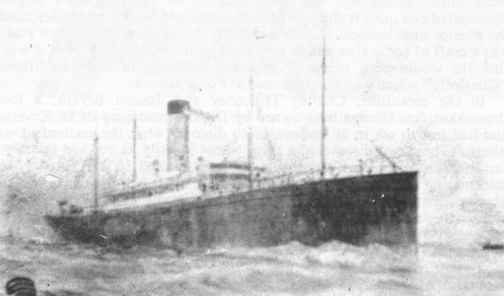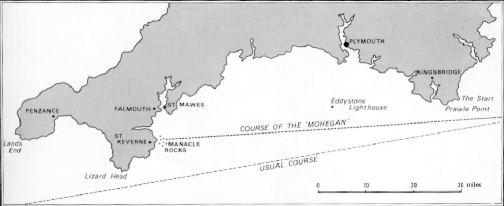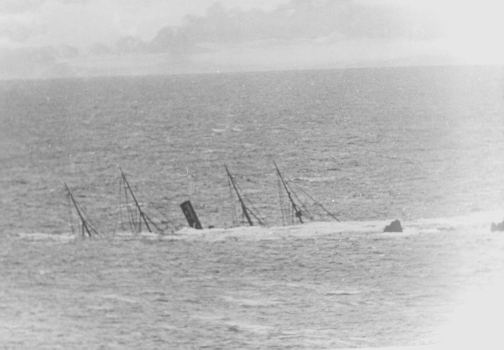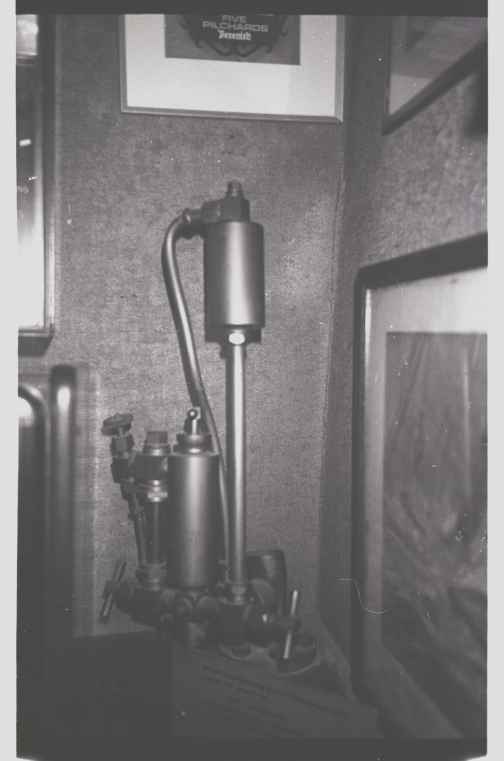The Mohegan, originally built as the Cleopatra by Earles of Hull, was a vessel of some 7000 tons. Prior to her launching she had been purchased by the Atlantic Transport Company of London on July 29th 1898. The Mohegan was an extremely luxurious and modern ship for her time, and as well as being fitted out in lavish Victorian style, she was also equipped with eight water tight compartments, with a steam pump capable of pumping out each compartment in turn. Measuring 482 feet in length and 52 feet at the beam, the Mohegan drew nearly 20 feet and was capable of a top speed of 14 knots. She carried 97 crew, about 60 first class passengers, and stockmen to attend the animals carried as deck cargo.

The Victorians however were hard taskmasters, and expected value for their money. So when the Mohegans completion was held up by a strike, the builders had to skimp on her specifications and rush her through to avoid the crippling penalty clauses for non-delivery. Her maiden voyage across the Atlantic causes a furore, and she leaked so alarmingly that she had to be docked in New York for repairs before returning to the Tyne for a complete refit. On 13th October 1898 the Mohegan set out on her second voyage. Once again bound for New York, the Mohegan left Tilbury with Captain Griffiths in command. She carried a full complement of 60 passengers and 97 crew, and her general cargo consisted mostly of beer and spirits. However, a fair proportion of the cargo also contained church ornaments and artificial flowers, an odd but faintly prophetic mixture.

At first all went well. The weather was quite good, and on the next day, October 14th the Mohegan found herself off Prawle Point, where she made a routine position signal to her owners. Later as she passed Rame Head, she was sighted by a signalman who was surprised to see her less than ten miles offshore. By then the Mohegans fate was almost sealed, because she was already steaming on a compass course that was hopelessly incorrect. At about a quarter to seven that evening, the passengers were just taking their places for dinner. In the first class cabins the nannies were supervising the children’s preparations for bed. On the bridge the lookouts were alert, and in the wheelhouse the helmsman was steering a course ordered by the officer of the watch, and personally checked by the Captain. All was as it should be.

Five minutes later the Mohegan, ablaze with lights smashed at full speed straight into the Manacles Reef, ripping a huge gash right below her waterline. Against this kind of damage the watertight compartments were useless, and several were flooded straight away. Within thirty seconds the engine room had to be abandoned, and very quickly the generators were flooded out plunging the whole ship into complete darkness. On the bridge, Captain Griffiths and his officers managed to fire off some distress rockets and started to get the passengers into the ships boats. However the Mohegans list to port soon became so severe that the starboard lifeboats could not be lowered, and so offered no escape. With threequarters of the ship underwater the Mohegan quickly sank, and within ten minutes of striking she was gone leaving those on deck to swim for their lives. Some managed to cling to the mizzenmasts rigging which remained above the water, but for 106 poor souls their end was at hand.

The loss of life would have undoubtedly been even greater but for the presence of mind of the Cox’n of the Porthoustock lifeboat, James Hill. When he saw the Mohegan coming across the bay, he realized that it would most probably hit the Manacles, and he had almost mustered his crew before the Mohegan struck. Two of the luckiest people to survive were a Miss Rondebush, and a Miss Compton-Swift. They had escaped the ship in a lifeboat, which was later overturned, and they were both trapped underneath the boat for over an hour before being rescued. Amongst those who perished were Captain Griffiths and all his officers. Survivors praised all of them for the cool and courageous way they had stemmed the tide of panic, when it became obvious that escape by the ships boats was hopeless.

In the aftermath of the disaster an inquiry was held into why the Mohegan had steered such an incorrect course. Many theories were put forward, but since the Captain and all the officers were dead no real conclusion could be reached, and the mystery has remained unanswered to this day. About the only good thing to come out of the disaster were new recommendations into the type of lifesaving equipment to be carried on all passenger ships. Most of the dead were buried in a mass grave at St. Keverne church which more or less overlooks the very spot where the Mohegan struck. Instead of a headstone a simple cross was erected. There was no epitaph, just one word ‘Mohegan’. Three months later the headless corpse of Captain Griffiths was washed ashore in Caernarvon Bay. The sea had finally finished with the Mohegan.

I had always wanted to dive this wreck because it is one of the classic wreck stories. Any wreck with this type of reputation is often over rated, but to my surprise I found the wreck fascinating. I first dived this wreck in 1982 and these were my first impressions.
The day was perfect, with the sea flat calm and the Manacles looking as innocent as apple pie. However the fog started to come down , and only about an hour of slack water we had to get on with the diving fairly quickly.

Incidentally for those who have never been to this part of the country, the Manacles looks like a lunar landscape and casts a brooding air over the whole proceedings.
The remains of the Mohegan are stuck down in between huge pinnacles of rock which are covered in pink and white dead mens fingers. The depth was about seventy feet, with the visibility around twenty feet. There are roughly two different dives on this wreck the first being the Mohegans massive boilers in about eighty five feet and the bow area where I was.
The bows are smashed up but lie on top of the rocks with their ribs stretching away into the distance. A very impressive sight. In amongst the mass of wreckage are the winches that were used to haul up her anchors, and further along were the remains of another boiler, about twenty feet in diameter which was probably used to power the winches. This boiler is extremely picturesque with some of it smashed open to reveal the pipes inside covered with pale pink dead mens fingers.

After that we sort of just wandered about this huge part of the wreck soaking up the atmosphere. The Wreck has a menacing charm all of it own. The wreck caused great loss of life, and it seems that some how that memory has been entombed with the wreck.
I next dived on the Mohegan in 1990 on the boilers. This time it was early morning and the viz was sixty odd feet. Honest. The boilers were massive and the mass of steel plating stretched into the distance like the M1. Looking up you could see the boat almost impaled by one of the huge rock pinnacle’s. A great dive on a great wreck.

GERRY says
i have some brass fittings from the MOHEGAN
i collect maritime objects.
i have always been facinated by this particular ship.
proberbly because of the mystery surrounding her end .
Hilary Cox says
Hi Gerry
I am, unfortunately, in the process of selling my mother’s house as she is now in a care home, and have always been intrigued by a musical box, which still works. There is a piece of paper inside the box which states SS Mohegan of Hull outward bound to New York, Oct 1898, 106 drowned but 44 were saved by Penthoustack Lifeboat…..
I can nly assume that this musical box came from the Mogegan, as my mother has very strong connections with Cornwall, especially St Mawes and Falmouth. My great grandfather, (my mother’s grandpa), Grandpa Green, was on the seas for many years …….
Perhaps you can enlighten me at all? I would love to hear from you.
Kind regards
Hilary Cox
Maxine Ingrouille-Kidd says
I too am fascinated by this ship, not least because my great uncle was a young boy, who lost his life on that fateful day. When I was a teenager I was shown a photograph of him, laid out with his eyes open. From that day, although somewhat spooked by it, I have always been interested. I was a little disappointed at the lack of information held in the maritime museum at Falmouth but am discovering more thanks to the internet. He is buried in Guernsey, where I come from originally. I was delighted to discover the church at ST. Keverne and locate the mass grave.
Maxine
jason gallway says
My great grandfather was a stow away on the Cleopatra and was put to work by the captain on the way back from New York, when the ship struck the rocks he swam ashore using a chest as a lift raft WITH the captain that had changed clothes!, in the chest which I have was the ships and captains log along with the ships manifest among other things, there was a disagreement with the owners and a company that had some experimental navigational equipment onboard being used which may or may not have caused the misshap as none of the ships officers were trained in its use. All very secret from what I can read of this Victorian writing. I have some stunning candle stick holders from her.
chris holwill says
Hi Jason Gallaway,
I am writing a book on the Mohegan. I am very interested in your note, particularly the chest and assoctaied documents – logbook, etc.
I wonder if you can email me and open up a discuassion.
Thanks.
Chris.
chris holwill says
Hi Maxine Ingrouille-Kidd
I am writing a book on the Mohegan. I am very interested in your note, particularly concerning a photograph of (I assume) Le Lacheur, John Guille from Guernsey. I would very much like to include this in my publication.
I look forward to hearing from you.
Chris.
Chrisholwill@yahoo.co.uk
John William Henry JUDDERY (Gandson) says
I have a LIFE SAVING medal awarded to my Grandfather by the BOARD OF TRADE together with one from LLOYDS and another possibly from the owners IN LATIN all for life saving on theMOHEGAN 14 OCTOBER 1898. No mention is made of this in any report i have read I believe was quarter master on her last voyage. He later became CAPTAIN J W H JUDDERY.
Lin Taylor greep says
The son of my 3 x great uncle lost his life onboard this ship. He was Murdock Chapple.
Maria Macc says
Gosh I just came across this wonderful site when researching the Steamer to develop a piece of artwork to be displayed in the Helston Museum. Chris Holwill… did you ever write that book. Amazing hearing the stories of folk who died and survived this unfortunate journey. Would love to hear what you have discovered!
Dr. Adrian Mark Kynaston Thomas BSc FRCP FRCR FBIR says
The First Officer of the Mohegan was my 2nd great uncle, Llewelyn Couch (1867-1898). A brave man. Thank you for posting.
Linda Ridd says
While on one of my many holidays in Cornwall, I visited St Keverne Church, there is a memorial to John Jago Smith who came from St Keverne and was one of the postmen on the ill fated RMS Titanic, the liner had both American and British mail workers they spent most of the sinking hauling about 600 first class mail bags up two flights of stairs in the futile hope of keeping them dry and saving them, a truly heroic effort. This is how I became aware of the tragedy of the ill starred SS Mohegan, thank you so much for your wonderful site, which I have just come across in searching for information re~ the Eyemouth Disaster. The postmens families on the Titanic were looked after financially by the American government under President Taft, unfortunately the British were not so lucky. St Keverne Church has a tragic but noble past.
Joseph Gallaway says
Christopher Gallaway
I live in Didcot Oxfordshire and have done since moving through my occupation on the railway in late 1959.
Born in 1942 in the then a small village of Probus Cornwall to a coloured/black father and a white mother. I was brought up with the knowledge of stories of my grandfather Daniel Gallaway who was on the SS Mohegan when the incident happened 1898. He married a local lady and had four children, my father Frank being the eldest of the four.
Daniel died in 1939 at sixty-three years of age in a workhouse and is buried with others in a run down church in Redruth.
I believe I am now the oldest male Gallaway alive in the UK.
Thank You
Ms Gayle Nykerk says
I was looking around in Buddock Church graveyard today and discovered a grave of 2 people who died aboard the Mohegan. The inscription reads: Death is swallowed up in victory. Sacred to the memory of
Helena Mary Cowan aged 27 years & Herbert Francis Cowan aged 24 years. Both born at Horsham Sussex who were taken home in the wreck of the Mohegan on Oct 14th 1898 on the manacles near this spot. Underneath are the everlasting arms. This is the victory that overcometh the world even our faith.
I hope this is of some use to someone.
GERALD DAY says
THE MOHEGAN is one of CORNWALLS greatest disasters . but the story is facinating . .at one time . divers wouldnt dive her . because of seeing strange lights and seeing things . this ended after a vicar . or priest dived her and layed to rest the souls of those that perished . there are a load of artifacts recovered from the wreck on show at the WRECK CENTRE CHARLESTOWN as i say i have some brass bits of her . GERRY
Robert Pyatt says
I too came across the grave of the Cowan’s at St Budock church in Cornwall , I wonder why the were buried there ?
Simon says
Currently working on a documentary about SS Mohegan and it’s history – would be great to have any one with relevant expertise reach out!
simon@honeybeemedia.co.uk